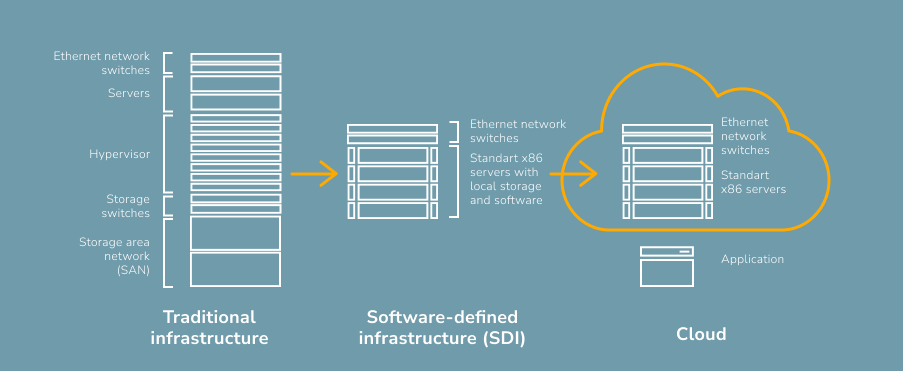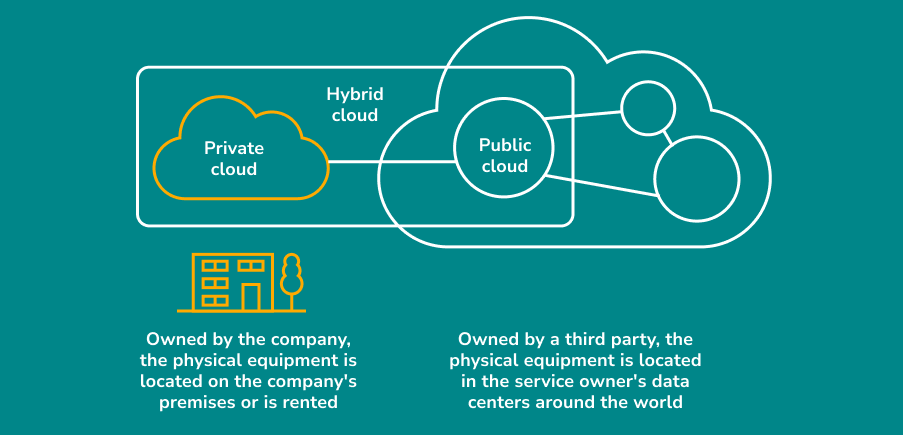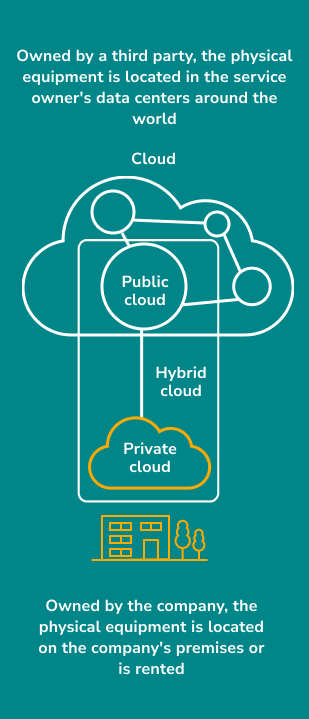Cloud Solutions ABC
You hear a lot about cloud technologies and their importance in the new digital economy, but what is the cloud? Cloud technologies grant you both simplified administration and wider access to IT systems and software – precisely to the extent of your requirements. You don’t have to worry about equipment and technical software; you can just use the cloud’s computing resources for your needs. This is as easy as simply subscribing to the required software as a service. The hosting solution can be tailored to your needs as well – in a public, private or a hybrid cloud.
IT infrastructure is made up of three main components that ensure the smooth running and administration of the IT department of any business – hardware, software, and network components. These allow you to run the three main functions in IT: Computing or data processing, Data storage, Data transmission. Previously, each of these functions necessitated specific equipment and software.
Traditional infrastructure
In traditional infrastructure, the data processing, storage, and transmission functions are separated and are ensured by different, function-specific pieces of IT equipment.
This equipment is owned and maintained by either the company itself or an outside contractor, along with the necessary premises to store and run it in.
Traditional infrastructure is characterized by a three-layer structure:
- The data processing layer, run on servers;
- The data storage layer, consisting of hard drive arrays and their support devices;
- The network layer, consisting of network switches and hypervisors that manage virtual machines.
Although this traditional infrastructure is relatively simple, it can quickly become expensive as operations grow and expand due to the need for expensive, specialized hardware, complex administration, and properly equipped premises or data centers.
Software-defined infrastructure (SDI)
With the advance of technology and increases in data processing capacity, it’s now possible to use simpler and more universal hardware components and administer IT infrastructure with software. This is called Software Defined Infrastructure (SDI), where you execute and administer data processing, storage, and network functions through the use of software.
The result is a dynamic infrastructure that is easy to maintain and administer centrally. SDI allows you to effectively manage resources, as well as address one of the main challenges in IT – scalability and storage resource expansion driven by the growth of IT needs. The software-defined approach allows for easier expansion of processes and solutions. It’s also cheaper, as you need to maintain less hardware, the hardware itself has more universal applications, and it’s often unnecessary to acquire new equipment.
Cloud infrastructure
Cloud infrastructure expands on the software-defined infrastructure approach, granting you greater opportunities to expand or decrease infrastructure according to your business needs, including in various geographic locations. Orchestration or the automation of infrastructure management processes increases both on a quantitative and qualitative level.
Cloud infrastructure allows users to step back from hardware and its maintenance, replacing technology as a product with technology as a service, thus allowing you to focus on core business processes.


Cloud Types
Depending on who owns and administers the cloud infrastructure hardware, there are various types of clouds – public, private, hybrid, and federated cloud architecture.


Public
cloud
Public cloud computing resources are provided by third parties through public internet. Clients have the opportunity to choose and use these services according to their needs.
The advantage of public cloud computing is the initial cost reduction – you pay only for the resources you use and don’t need to employ IT specialists or purchase and maintain software and physical equipment. The public cloud is easy to integrate and activate and it offers simple and almost limitless scalability.
If you choose a public cloud computing provider, you must accept a certain degree of reliance on the service provider as the costs increase as your data needs grow. This cost growth is not always easy to forecast. You must also be ready for potentially complex payment plans and other limitations of standardized solutions.
Examples of public cloud services: Google Cloud, Microsoft Azure, Amazon Web Services.
Private
cloud
Private clouds provide cloud computing services within a single organization through the internet or the organization’s intranet. This requires physical equipment that is located on the premises of the organization or an outside contractor. The responsibility for management and administration of a private cloud lays with the organization’s own administrative and IT departments, although it is possible for the system to be maintained by a third-party IT contractor.
Private cloud allows the transformation of the company’s existing infrastructure and offers the same benefits that public clouds offer, even for functions traditionally maintained within the organization. This includes the possibility to set up remote access to data and applications through various devices.
You have greater control and more flexibility to adapt to and reconfigure the services you make use of with a private cloud service. This translates to more detailed monitoring and a higher level of privacy, which is especially important for organizations working in more highly regulated industries.
Setting up private cloud systems initially takes more time due to the need to reconfigure and adapt existing infrastructure or set them up from scratch. In addition, it is necessary to devote more resources to equipment, personnel, and administration than with a public cloud service.
Private cloud service examples: VMware Cloud, IBM/Red Hat Cloud, Flex Cloud.
Hybrid
cloud
Hybrid clouds come about when public and private cloud infrastructure is integrated, which allows for data and application use across both cloud environments. Such a setup decreases a business’s reliance on service providers and allows for dynamic use of various alternative cloud solutions and choosing the ones most suited to your needs. A business can more effectively use its IT resources, avoiding higher licensing and subscription fees. Such a hybrid solution also allows you to protect critical components of your business in a private cloud network.
Effective use of hybrid clouds allows you to quickly address short-term surges in demand without an additional long-term investment of resources. Hybrid setups are platforms that offer the best of both worlds, as they offer all the benefits of cloud computing – elasticity, scalability, and optimization of expenses – together with higher security levels.
Federated
cloud
This type of cloud connects various geographically diverse assets of a business into connected cloud environments. A federated cloud allows for the infrastructure to be administered both centrally and in a decentralized manner. It can be hosted and run on a public cloud service provider’s network as well as on the data centers of different cloud service providers and third parties.
Edge
computing
Technologies are developing at rapid speeds and offer businesses new opportunities. As an example, AI and big data analytics operations require a high processing capacity for you to be able to make time-sensitive decisions and deliver results quickly. The same applies to simultaneous translation or computer vision.
In such cases, the use of public cloud networks can be too risky, as it is hard to guarantee a stable and high data transmission speed. That’s why demand is growing for high-speed computing capabilities close to the consumer. This principle is called edge computing, and it is realized in various ways – from integrating a computing node into a business platform, such as an assembly line or drone, to maintaining a private cloud nearby with a task-specific configuration. If it is more beneficial to handle the other business functions on a public cloud, a hybrid cloud solution works best.
Cloud Computing Service Models
There are three main models for cloud computing services – Infrastructure as a Service (IaaS), Platform as a Service (PaaS), and Software as a Service (SaaS). Each of these models defines the responsibilities of and relationship between the service provider and client.
SaaS
Software as a service provides access to products that are developed and managed by software developers. Access to the software in question allows the client to focus only on utilizing it, as the responsibility for providing, maintaining, and updating it lies with the service provider. A typical example of SaaS is e-mail or data backup services, with the business storing and managing data without needing to think about the software updates or server and operating system maintenance that is required for the smooth functioning of the service.
PaaS
Platform as a Service grants access to and usage of devices and platforms that the platform service provider offers. PaaS service providers ensure access to the necessary infrastructure – virtual and physical devices, networks, and storage – but also to operating systems, middleware, and database management software, allowing the client to concentrate resources on critically important application administration and development without spending those resources on infrastructure setup and configuration.
IaaS
Infrastructure as a Service creates the foundation for a business’s cloud technology system. It allows for access to the main resources of IT infrastructure – servers, virtual or physical devices, networks, and storage. IaaS ensures flexible access to infrastructure resources that can be configured to a business’s specific data processing and storage needs. A typical IaaS solution combines virtual machines and data storage centers. Each element is tailored to fit the organization’s needs.
Responsibilities Between the Service Provider and Receiver
On-Premises
infrastructure
IaaS
Infrastructure as a Service
PaaS
Platform as a Service
SaaS
Software as a Service
Applications
Data
Runtime
Middleware
O/S
Virtualization
Servers
Storage
Networking
Applications
Data
Runtime
Middleware
O/S
Virtualization
Servers
Storage
Networking
Applications
Data
Runtime
Middleware
O/S
Virtualization
Servers
Storage
Networking
Applications
Data
Runtime
Middleware
O/S
Virtualization
Servers
Storage
Networking
